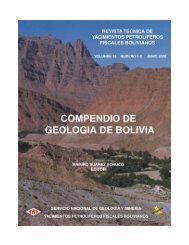Create successful ePaper yourself
Turn your PDF publications into a flip-book with our unique Google optimized e-Paper software.
During the final stages of the Jurassic volcanism, and a as a result of the elevated geothermic gradient in<br />
the upper crust, a regional hydrothermal activity took place all over the Deseado Massif, generating<br />
epithermal mineralization in deepness, with some feeders reaching the surface.<br />
In the studied area, several manifestations of the Jurassic hydrothermal activity were recognized:<br />
epithermal veins and breccias with Au-Ag anomalies, hydrothermally altered rocks, calcareous<br />
stromatolites and silica sinter; all of them representing different levels within the epithermal model.<br />
The main mineralised structures in the area are: Eureka, La Mariana north and La Mariana south veins.<br />
Eureka vein is 4.5 km long, with a N305° azimuth, commonly dipping 75° to the SW. There were<br />
recognized seven pulses within the vein. Its main characteristics have regular variations, indicating a<br />
three segments subdivision: northwest, centre and southeast.<br />
Eureka northwest has a main vein outcrop ranging from 5 to 25 m in width, filled by quartz and<br />
chalcedony with banded and breccia textures and a strong quantity of Fe-Mn oxides. In this sector the<br />
vein is hosted in the andesitic lava flows and the subvolcanic andesitic body, both with intense propylitic<br />
alteration.<br />
Eureka centre is represented by three or four branches of 1 to 3 m in width each, with the same kind of<br />
infill but with a strong participation of brecciated textures. In this case, the host rocks are ignimbrites with<br />
a strong argillic and silica hydrothermal alterations.<br />
Eureka southeast is the most regular of the three subdivisions. It has up to 2 m wide, and is composed by<br />
a dense stockwork to breccia with clasts of quartz in a Fe-rich silica cement and with Fe oxides<br />
associated. This structure is hosted in ash-fall pyroclastic facies.<br />
La Mariana north vein is 200 m long, up to 2 m wide and with a N260° strike. It is filled by banded and<br />
breccia quartz textures, occasionally porous with limonitic infilling. This vein is hosted in argillic and oxide<br />
altered, grey to violet coloured, reworked volcanic facies.<br />
La Mariana south vein is characterized by discontinuous outcrops along a 100 m long structure, and it<br />
has up to 1 m in width. It has variable strike between N280° and N290°, and is vertical. It is composed by<br />
a quartz stockwork, with some brecciated texture. It is very important the participation of Fe-Mn oxides. In<br />
this case the host rock is the undifferentiated volcanic facies with a strong alteration (mainly oxidation).<br />
Seven more sectors with evidences of hydrothermal mineralization were recognized: Vetilleo Norte, Cerro<br />
Solo, Área Puesto Solo, Paragüitas, Brecha Centro Volcánico Cerro Tetis, Brecha Hidrotermal Central y<br />
Brecha La Mariana. They are characterized be the presence of quartz or calcite veinlets, or silica<br />
hydrothermal breccias, in general interpreted as upper levels of the epithermal system.<br />
Also some surface manifestations of the hydrothermal activity are present in the area: carbonate<br />
stromatolites and a silica sinter.<br />
At same time this activity is present in the area as extended outcrops of hydrothermally altered rocks. The<br />
main alterations are argillic, silicic and propylitic, occurring one or other depending principally on the<br />
primary composition of the rocks.<br />
The mineralogy, quartz structures and textures, hydrothermal alteration, metals geochemistry, fluid<br />
inclusions, stables isotopes and lead isotopes were studied in order to understand and classify the<br />
different epithermal evidences.<br />
The mineralogy of the veins was studied by petrography, chalcography, electronic microscope and X-ray<br />
analyses, characterizing two main systems in the area: one with silica (mainly quartz) and other with<br />
<strong>Lopez</strong>, R., <strong>2006</strong>. <strong>Tesis</strong> <strong>Doctoral</strong>. FCNyM-UNLP.

















